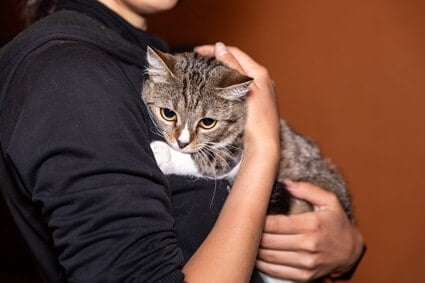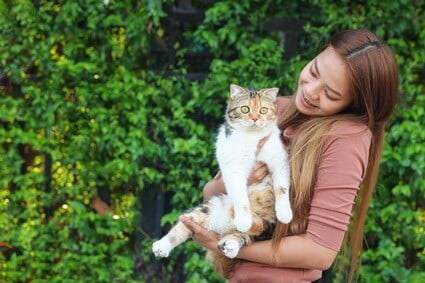The dynamic between cats and humans is hard to define. Cats misbehave and do as they please around the house, but they don’t make too much fuss when a human puts their foot down. Little is understood about the way cats see us, and even less is known about what it takes to be an alpha in a cat’s eyes.
In truth, cats don’t have a hierarchy when it comes to humans. Among other cats, they have agreements about who gets which corner of the house. However, because humans go wherever they want in their home, cats have to share with us, even if we’re in their favorite spot.
Any territorial behavior a cat may display has little to do with a human’s “alpha” status in the cat’s eyes. Behavioral issues, feelings of fear, and stress influence a cat’s behavior more than any hierarchy.
Do Cats Have a Hierarchy with Humans?
According to Science Direct, neither domestic nor feral cat groups abide by a linear hierarchy. Since there’s no hierarchy among themselves, there’s no hierarchy when between cats and humans.
In multi-cat homes, cats have loose agreements with each other over who owns which part of the house. The cat that is best able to establish boundaries is the one that gets the spot.
This has little to do with which the more dominant cat and more to do with which cat is:
- More stubborn at the time of claiming space
- Older (though age is only a factor between adults and juveniles)
- Healthier
- Senior to the household (lived there longer)
Even then, the agreements made between cats can change. Cats rotate ownership of their territory often and don’t mind sharing among mates or cats they get along with. So, how does clowder behavior apply to cat-human relationships?
Even though cats consider us to be part of the clowder, they still think we are at least different from them. We don’t always respond accordingly to their communication efforts because we don’t have the same body parts or ability to vocalize.
Cats even understand that they have to tailor their communication style to us to get what they want. This is why they meow so much in front of humans but don’t in front of other cats.
With this understanding in mind, cats know there’s little they can do when we step into their territory. If you need to push your cat off its favorite spot on the couch, it may hiss and swat at you as a feeble attempt at defending what it considers to be its spot.
However, your cat won’t be able to do much when you carry it off the couch. It knows that when it comes to humans, the rules don’t apply. Either that or it loves you enough to want to share the spots with you.
Do Cats Have an Alpha Human?
Cats are incapable of considering a human to be an alpha. They have no concept of alpha and beta dynamics, even among themselves.
If you feel like your cat doesn’t respect you but respects another member of the house more, it’s not because it thinks you are weak. It just doesn’t feel attached to the other person.
So, if you’re the one that feeds and cuddles with the cat, why does it refuse to obey you when you tell it to get off the counter? Why does it immediately jump off when a housemate that spends the least amount of time with it repeats your same command?
It’s not because the cat senses that your housemate is the alpha and you aren’t. It’s simply because cats are naturally non-confrontational.
Cats form the deepest bonds with humans that feed them, talk to them, play with them, share a space, and pet them often. Another member of the household may not be as affectionate, leading the cat to avoid that person.
Cats don’t fight for territory with humans they don’t care about because it’s a waste of energy.
How Do Cats Show Submission to Humans?
Cats don’t show submission to humans. What may seem like signs of submission from a cat may be apathy. According to the Journal of Veterinary Behavior, cats lack ritualized submission signals.
Cats began living with humans some 10,000 years ago, so they became more social—not just with humans but also with other cats. Contrary to popular belief, social creatures survive longer when they work together as a team instead of fighting over who dominates the others.
If a cat doesn’t put up a fight after we order it to do something, it’s not because it recognizes that we have authority. Cats love their owners enough to want to share spaces.
If the cat isn’t fond of the human, it’ll move out of the person’s way because fighting isn’t worth it.

Do Cats Show Dominance to Humans?
When cats behave aggressively towards humans, it’s not because they want to establish dominance.
Research has shown that aggression in cats doesn’t guarantee reproductive success or better access to resources. What may seem like displays of dominance might be fear, a behavioral problem specific to that cat, or normal defensive behavior.
According to the University of Helsinki, cats aren’t naturally aggressive. Male cats can be aggressive when near a female cat in heat, but this is purely situational and has nothing to do with a cat’s desire to dominate other cats.
Uncharacteristic aggression is associated with early weaning, so an aggressive cat could have grown up to be docile under the right circumstances.
When afraid or under stress, cats will engage in behavior that seems aggressive to us humans, such as:
- Flattened ears
- Hissing
- Scratching
- Biting
- Angry vocalization
However, these are all signs that the cat is just trying to defend itself. If a cat reacts this way to being approached or touched, it means that it’s afraid, not that it wants to challenge your authority. Stress, illness, and trauma can turn an otherwise friendly cat into an overly defensive or aggressive one.

How Do You Get a Cat to Respect You?
Getting a cat to respect your authority takes time and effort. It isn’t impossible to train them, and part of living in harmony with a cat is understanding that they won’t always do what you say. Cats aren’t fully domesticated yet, so there will always be times when a cat will do what it wants.
To train a cat, you’ll primarily need to use positive reinforcement and corrective behavior. Punishing a cat after you order it to do something isn’t fair to the cat because it doesn’t speak our language.
Even speaking in an angry tone of voice isn’t always something they fully understand. Using different methods and centering the training around your cat’s personality is far more effective.
If you want a cat to do what you say, the most effective methods involve:
- Clicker training
- Treats
- Short training sessions
- Focusing on one behavior or command at once
- Using different vocal intonations
After a long period of behavior training, if your cat still doesn’t respect what you say, it doesn’t necessarily mean that it thinks you’re weak.
Some cats are difficult to train, especially if they are already adults. If you’re desperate for your cat to respect you, you can always contact a cat behaviorist.
Cat Hierarchy with Humans
Cats don’t have a strict hierarchy with humans.
It may seem like they sometimes undermine our authority as their owners, but if you have a good relationship with your feline, its hissing and fussing indicates that it thinks you are part of its family.
Cats frequently mark and defend their territory and resources among themselves. However, instead of constantly fighting and having everything go to an “alpha,” cats signal to each other when they intend to:
- Take something
- Defend what’s theirs
- Give it up to another cat
They do this through body language and vocalization. The way they communicate seems aggressive and unfair, but to them, this is how they discuss who gets what and what gets shared between them.
When a cat seemingly challenges you by hissing, hitting you, or growling, it means that it wants to have a discussion with you, using methods it would with any other cat.
We can’t communicate with our cats the way they want us to, so they give up when they understand they can’t defend their property against us. Instead, they decide to share it.

